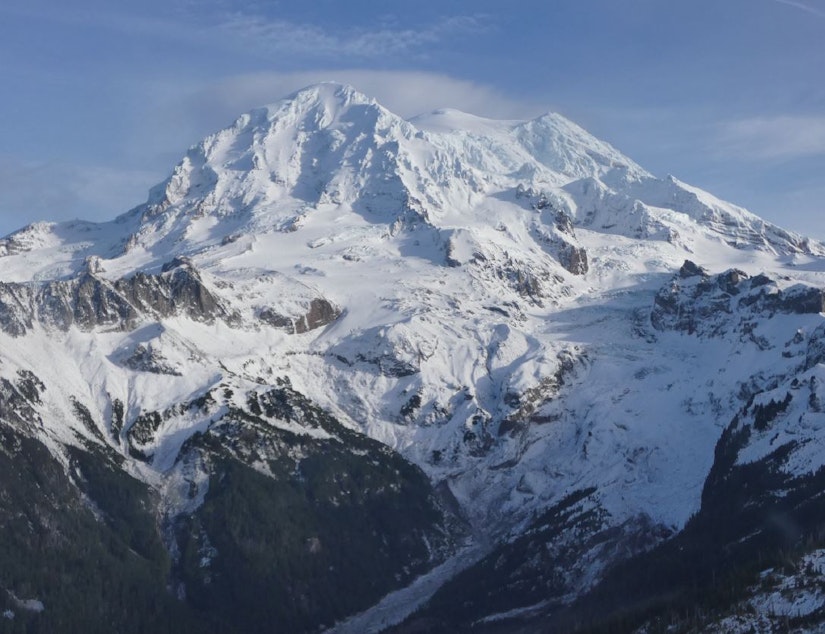Another three bite the dust: Heat melts Mount Rainier glaciers

A warming climate has claimed three more glaciers in Washington state. These three were all on Mount Rainier, home to more ice than any American mountain south of Alaska.
In June, National Park Service researchers published their finding that the Stevens Glacier, on Rainier’s southern slopes, had shrunken so severely that it could no longer be considered a glacier.
“It's still kind of a perennial snow patch,” said Mount Rainier National Park geologist Scott Beason. “If you go up there, you'll still run into some snow, but you're not going to see crevasses. You're not going to see movement.”
Glaciers are rivers of ice that flow as their own weight compresses snow into ice. The slow, grinding movement generates striking features like deep crevasses and deep-blue ice.
The study, based on 3-D images taken of Mount Rainier from a specially outfitted airplane in September 2021, declared two other south-facing glaciers, the Pyramid and Van Trump, “in serious peril,” having lost 42% of their ice in the previous six years.
More recent satellite imagery, from October 2022, led glaciologist Mauri Pelto of Nichols College to conclude the Pyramid and Van Trump glaciers had also melted away.
Sponsored
“With the current climate there, it was a matter of when, not if,” Pelto said.
“As we continue to have these warm summers and these heat waves, all the glaciers are going to really suffer, and any glacier that's not in pretty good form is going to be lost,” he said.
The three rivers of ice on the southern slopes of Mount Rainier were the latest victims of a warming climate.
The Pinnacle, Unicorn, and Williwakas glaciers disappeared from Mount Rainier during the 20th century, according to Beason.
Glaciers in the North Cascades and on the slopes of Mount Adams cover half the area they did at the start of the 20th century.
Sponsored
Pelto led a team into a remote portion of the Alpine Lakes Wilderness in August 2022 and reported the disappearance of Hinman Glacier, formerly the largest glacier between Mount Rainier and Glacier Peak, 90 miles to the north.
Before the heat waves of the past two summers, Mount Rainier had 29 glaciers with names. Now it’s down to 26.
The three lost glaciers never held more than a small fraction of Rainier’s ice. Massive glaciers still stretch for miles from the volcano’s 14,411-foot summit.
Still, geologists say the melting will continue in coming decades as fossil fuel emissions keep heating the planet.
“This is the course that all the glaciers are going to end up taking unless we take some action,” Pelto said.
Sponsored
“There still will be ice,” Beason said. “None of the models show no ice on Mount Rainier, but a lot of the lower elevation glaciers will likely disappear.”
As the mountain’s icy cloak keeps shrinking, the lost ice could mean warmer, less hospitable water for salmon and less hydropower from dams on the Nisqually River each summer. A barer, browner Mount Rainier would also stand out less on the horizon.
“One of the reasons that Mount Rainier is so distinctive is that it has the white blanket of ice on it and it reflects light really well, so people can see it from a long distance away,” Beason said.
In the short term, the increased melt can bring higher summertime river levels and dangerous debris flows as glaciers break apart and the sediment within and beneath them is liberated. The Pyramid and Van Trump glaciers both unleashed destructive debris flows following heavy rains in November 2006.
Park Service researchers say the Northwest’s tallest peak has lost half its ice since 1896, with the losses accelerating in recent years.
Sponsored
Given the warming already baked into the climate by human pollution, Pelto says it’s too late to save the Northwest’s smaller glaciers.
But he says it’s not too late to slow global warming enough to save the Northwest’s bigger glaciers from melting away.
“I do think we have to acknowledge when glaciers disappear,” Pelto said.
Pyramid Glacier sat near Pyramid Peak, named for its shape, while Van Trump and Stevens glaciers were named for Philemon Van Trump and Hazard Stevens, two mountaineers who made the first documented climb to Rainier’s summit in 1870.
As the three lost glaciers dwindled over recent decades, they crumbled into isolated patches of stagnant ice, often about the size of a little league baseball field. The dozens of withered ice chunks are too small to move or form crevasses, the defining characteristics of a glacier.
Sponsored
Rest in pieces, Pyramid, Stevens, and Van Trump glaciers.




